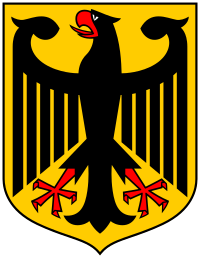Coat of arms of Germany
| Coat of arms of Germany Bundesadler |
|
|---|---|
 |
|
| Details | |
| Armiger | Federal Republic of Germany |
| Adopted | 20 January 1950 |
| Escutcheon | Or, an eagle displayed sable armed beaked and langued gules |
The coat of arms of Germany displays a black eagle with red feet, beak and tongue on a golden field, blazoned: Or, an eagle displayed sable beaked langued and membered gules. This is the Bundesadler or "Federal Eagle", formerly the Reichsadler or "Imperial Eagle".
It is a re-introduction of the coat of arms of the Weimar Republic (in use 1919–1935) adopted by the Federal Republic of Germany in 1950. The current official design is due to Tobias Schwab (1887–1967) and was introduced in 1928.
The German Empire of 1871–1918 had re-introduced the medieval coat of arms of the Holy Roman Emperors, in use during the 13th and 14th centuries (a black single-headed eagle on a golden background), before the emperors adopted the double-headed eagle, beginning with Sigismund of Luxemburg in 1433. The single-headed Prussian Eagle (on a white background, Argent, an eagle displayed sable) was used as an escutcheon to represent the Prussian Kings as dynasts of the German Empire. The Weimar Republic introduced a version in which the escutcheon and other monarchical symbols were removed.
The German Imperial Eagle (Reichsadler) originates from a proto-heraldic emblem believed to have been used by Charlemagne, the first Frankish ruler crowned Holy Roman Emperor by the Pope in 800, and derived ultimately from the Aquila or eagle standard, of the Roman army.
By the 13th century the imperial coat of arms was generally recognised as: Or, an eagle displayed sable beaked and membered gules (a black eagle with wings expanded with red beak and legs on a gold field). During the medieval period the imperial eagle was usually single-headed. A double-headed eagle is attributed as the arms of Frederick II in the Chronica Majora (c. 1250). In 1433 the double-headed eagle was adopted by Sigismund, Holy Roman Emperor. Thereafter the double-headed eagle was used as the arms of the German emperor, and hence as the symbol of the Holy Roman Empire of the German Nation. From the 12th century the Emperors also used a personal coat of arms separate from the imperial arms. From the reign of Albert II (reigned 1438–39), the Emperors bore the old Imperial arms with an inescutcheon of pretence of his personal family arms, which appears as the black eagle with an escutcheon on his breast.
...
Wikipedia
